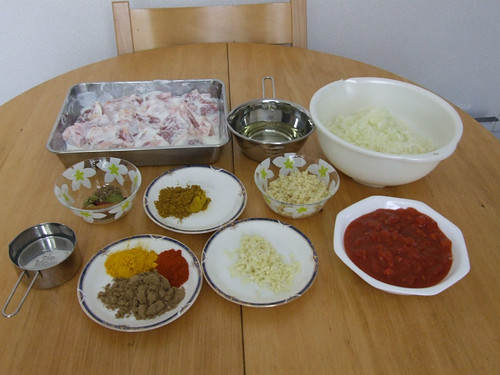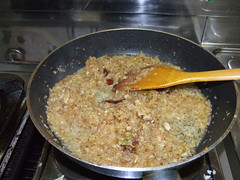skip to main |
skip to sidebar
Le Sukiyaki est une sorte de fondu japonaise. Un pur delice generalement decuste avec un oeuf cru.
Ingredients
Pour environs 4 personnes
- 400gr de boeuf en tranches minces
- 1 cube de YakiDoufu (tofu grille) ou de tofu normal
- 2 branches de naga-negi (onion long japonais)
- 1/4 de choux chinois
- 1 paquet de champignions japonais (shiitake, shimeji, enokitake...)
- 1/2 tasse de Sauce Soya
- 1/2 tasse de Mirin (sake doux)
- 1/4 tasse de sake a cuisine
- 1/4 tasse d'eau
- 2tbsp de sucre
- Un cube de gras de boeuf (de l'huile c'est aussi bien)
- 1tbsp de sucre
- 4 oeufs
Preparation
Couper les legumes en bouche facile a manipuler avec des baguettes et mettre dans une grande assiettes.
Amener les ingredients de la sauce a ebulition (sauce soya, mirin, sake, eau et sucre). Laisser reposer le temps de cuire les premiers morceaux de viande.
Dans une poele a frire assez profonde, faire fondre le gras et y rajouter quelques morceaux de viande et le sucre. Cuire la viande puis rajouter une portion de legume et la sauce. Laisser bouillir jusqu'a ce que les legumes deviennent mous et delicieux ! A manger directement dans la poele.
En general, une fois que la premiere batch de legumes a bien ete melange avec la sauce, l'ideal c'est de mettre la poele sur un rechaud dans le milieu de la table et de rajouter des legumes de temps a autre en mangeant directement de la poele. Casser dans un bol un oeuf pour chaque convive et tramper la viande ou les legumes brievement avant de les manger. Bien que pour beaucoup d'occidentaux cela semblera etrange, je vous garantie que c'est d'autant plus delicieux !
Finalement, si vous n'etes pas amateur de boeuf ou si le noms des legumes ne vous dit rien, le secret de ce plat est dans la sauce et je suis certain que n'importe quel melange de legumes et de viandes sera parfait.
Sukiyaki is a kind of japanese "hot pot". Very delicious and usually eaten with a raw egg.
Ingredients
Makes for about 4 people
- 400gr slices of beef
- 1 square of YakiDoufu (fried tofu), normal tofu is also good
- 2 naga-negi (long chinese onion)
- 1/4 Chinese cabage
- 1 pack each of shimeji and/or winter mushrooms
- 1/2 cup Soy sauce (100ml)
- 1/2 cup of Mirin (sweet sake)
- 1/4 cup of cooking Sake
- 1/4 cup of water
- 2tbsp of sugar
- A cube of beef fat or oil
- 1tbsp of sugar
- 4 eggs
Preparation
Cut all the vegetables in medium-sized pieces (easy to pick up with chopsticks). Place in a plate.
Heat the sauce (soy sauce, mirin, sake, water and sugar) first and bring to a boil then remove it from the stove.
Melt the beef fat in a deep pan then add a few pieces of beef and put 1tbsp of sugar and cook the meat. Add the sauce and some vegetables. Let it boil till the vegetables are cooked and eat straight from the pan.
This will sound strange to westerners, but put the raw egg in a cup and use it as a sauce to dip vegetables and meat in. It really adds to the flavor !
Usually, once the first batch of vegetables and the sauce have been mixed in the pan, the ideal way of eating is to put the pan in the middle of the table on a portable stove so everyone can add vegetables, meat and eat straight from the pan.
Also, if you have trouble finding the right vegetables or if you don't like beef, I'm sure any assortment of vegetables will make for a delicious experience.
Actually, more like the Japanese version of the Chinese delicacy !

Some ingredients might be a bit difficult to find,
but you can easily change them for something similar
Ingredients
Make for around 35-40 gyoza
- 1/4 Cabage
- Leek
- 350g Ground pork
- 1tbsp Cooking sake
- 1tbsp Soy sauce
- 1 1/2tbsp tobanjan (Chinese Miso)
- 1tbsp Sesame Oil
- 1tsp Sichuan Pepper (Chinese Pepper), can be replace with normal pepper
- Pinch of salt
- 1tbsp Potato Starch or Corn Starch
- Gyoza sheet
Preparation
Chop the vegetables in small pieces and put in a bol. Add salt and let it rest for about 10 minutes. Squeeze the mix over the sink to remove as much water as possible. The mix should nearly half in size.
Add the meat and mix together then add the potato starch and mix some more. Add the sake, soy sauce, miso, chinese pepper and sesame oil. Mix everything.
Take a gyoza sheet and put some of the mix in the middle (leave about 1 or 2 centimeter free on the side), wet the side by dipping your finger in water and passing it around the outside of the gyoza sheet then close the sheet by folding one side over the other in a zigzag shape.
There is two ways of cooking gyoza. The first one is fried gyoza and the second one is boiled gyoza. Fried Gyoza are more dry and easier (in my opinion) to pick up with chopsticks. Boiled gyoza are easier to make especially when they are frozen.
Fried Gyoza

Put a bit of oil in a frying pan and put the gyoza flat on the frying pan. Cook at medium power the gyoza until the bottom becomes golden. Add about 50ml of water for 10 gyoza. If your frying pan is bigger you might need more water. Cover and let it cook until the water evaporates (around 5 to 6 minutes).
Boiled Gyoza
Put water in a pot and bring to a boil. Add the gyoza and let it boil until the gyoza float to the surface. This can take anything between 10 minutes to 20 minutes if the gyoza are frozen.
Note : Gyoza are great to eat with some rice and miso soup. You can also use them as a side dish with Ramen or the sort.
They go very well in the freezer. Ideally, put the plate in the freezer for a while until they start to harden and then you can throw them in a bag at the back of the freezer without damaging them and you can keep them for a long time.
In Japan the Gyoza sheets are round but chinese gyoza sheets are often square but the technique to make them is quite similar.
Usually you eat gyoza with some kind of sauce. The two common one are : Soy Sauce with a bit of Rahyu (some spicy oil) or with Chinese Vinegar. Personally I like the chinese vinegar, my parents prefered the soy sauce + spicy oil mix, it's up to you to find out !
The basic principle of gyoza is green vegetables and meat in a wrap so don't hesitate to change the vegetables and the meat to discovert great new tastes ! Carrots or potato and the sort might be strange, but chinese radish, garlic, ginger or any chinese vegetables will be a sure threat !









